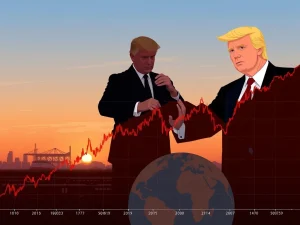Shocking Ethereum Price Drop to 2-Year Low: Why Pro Traders Still See Hope

Just when you thought the crypto markets were finding their footing, Ethereum (ETH) took a nosedive, plummeting to a chilling $1,400 on April 7th. This marks the lowest point for ETH since March 2023, sending ripples of concern through the crypto community. Was this just another dip, or is there more to this dramatic Ethereum price fall? Let’s dive into the market analysis to uncover what’s really happening and why some pro traders are surprisingly optimistic.
Why Did Ethereum Price Plunge to a 2-Year Low?
The immediate trigger for this sharp decline was a mix of factors, primarily worsening macroeconomic conditions. Investors are increasingly worried about global trade tensions potentially leading to a recession. This economic uncertainty naturally reduces appetite for riskier assets like cryptocurrencies. Here’s a breakdown of the key pressures impacting the ETH price:
- Global Economic Concerns: Fears of recession fueled by escalating trade tensions are making investors wary of risk-on assets.
- Delayed Fed Rate Cut Impact: Hopes for a positive crypto market boost from a potential US Federal Reserve interest rate cut in May are diminishing. Despite pressure from figures like Donald Trump for rate cuts, Fed Chair Jerome Powell remains cautious due to inflation concerns.
- Pectra Upgrade Delay: Ethereum developers postponed the much-anticipated Pectra upgrade, initially planned for April, now targeting May 7th. While the Hoodi testnet was successful, the lack of a clear reason for the delay adds to market uncertainty.
- Leverage Liquidations: The price drop triggered massive liquidations of leveraged ETH futures, exceeding $370 million in just two days, further exacerbating the downward pressure.
Despite the bleak picture, crypto market analysis reveals a more nuanced situation, particularly when examining how professional traders are reacting.
Are Pro Traders Really Panicking About the Ethereum Price Drop?
Surprisingly, despite the significant Ethereum price drop, data suggests that seasoned traders aren’t hitting the panic button just yet. While the market sentiment is undeniably bearish, key indicators reveal a level of resilience and even a glimmer of hope. Let’s look at the data:
Ethereum Futures Market: A Sign of Cautious Optimism?
Analyzing Ethereum futures contracts offers insights into professional trader sentiment. The Ether monthly futures premium, while still below the neutral 5% threshold, actually increased to 4% on April 7th after dipping to 3% earlier. This slight rise, from a low of 2% at the end of March, indicates a reduced demand for bearish positions below the $1,600 level. While long positions (buyers) are currently subdued – not unexpected after a 30% price drop – the futures market isn’t signaling extreme bearishness.
Options Skew: Bearish, But Not in Panic Mode
The 25% delta skew in Ethereum options further supports this view. This metric compares the premium for put (sell) options versus call (buy) options. A high positive skew (above 6%) indicates strong bearish sentiment as put options become more expensive. Currently, the ETH options skew is at 10%, which is bearish territory. However, it’s crucial to note that this is significantly less extreme than the 20% peak seen in May 2024 during a similar price correction. This suggests that while bears are present, they are not exhibiting panic levels seen in previous significant downturns. The Ethereum futures and options data together paint a picture of cautious bearishness, not outright capitulation.
Ethereum On-Chain Metrics: A Hidden Strength?
Beyond derivatives, on-chain metrics for Ethereum reveal an interesting counter-narrative. While the Ethereum price faced downward pressure, the Total Value Locked (TVL) on the Ethereum network actually surged to an all-time high of 30.2 million ETH on April 6th! This represents a remarkable 22% increase month-over-month, outperforming growth in TVL on competing blockchains like Solana and BNB Chain. This TVL growth suggests continued, and even increased, confidence in the Ethereum network’s underlying technology and applications, despite the price volatility. Could this be a fundamental indicator that overshadows short-term price fluctuations?
Navigating the Volatile Ethereum Market: What’s Next?
While the Ethereum price drop to a 2-year low is undoubtedly concerning, a deeper dive into crypto market analysis reveals a more complex picture. Pro traders, as indicated by futures and options data, are not in full panic mode. Furthermore, the record-breaking TVL on Ethereum suggests strong underlying network health.
Key Takeaways:
- Macroeconomic factors are primary drivers: Global economic uncertainty and inflation concerns are weighing heavily on crypto markets.
- Derivatives data shows bearishness, but not panic: Ethereum futures and options suggest cautious bearish sentiment, not extreme fear.
- Ethereum TVL hits all-time high: On-chain data reveals strong network growth and user confidence despite price drops.
- Potential for limited downside: The combination of derivative data and TVL growth suggests the Ethereum price downside might be limited in the short term.
Ultimately, predicting short-term price movements in the volatile crypto market is impossible. However, by analyzing diverse data points – from derivatives markets to on-chain metrics – we can gain a more informed perspective. The current situation with Ethereum highlights the importance of looking beyond just price charts and understanding the underlying dynamics of the market and trader behavior. While the recent price drop is a stark reminder of crypto market volatility, the resilience shown in derivatives data and on-chain metrics offers a glimmer of hope for bullish investors.
Disclaimer: This article is for informational purposes only and not financial advice. Conduct thorough research before making any investment decisions.








